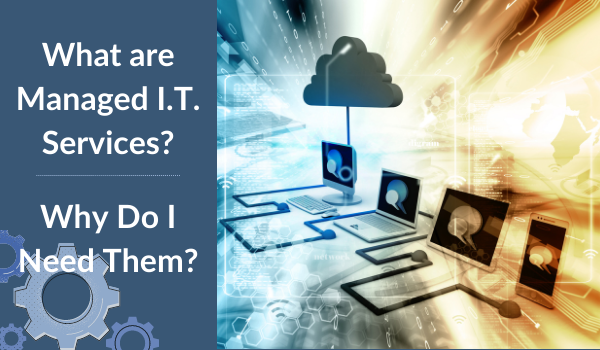I.T. infrastructure is the cornerstone of any organization, regardless of size. Because of its importance and complexity, maintaining this infrastructure is no easy task. From computers and phones to networks and passwords, managing an internal I.T. environment can be time-consuming and difficult to predictably budget. While this is valid for any company, it’s particularly daunting for small to medium businesses (SMBs) that traditionally have lower budgets and fewer resources to keep their systems running and their data safe.
What Are Managed I.T. Services?
“Managed I.T. Services” isn’t just a catchphrase; it involves outsourcing or offloading your I.T. management to a team of external experts, known as Managed Service Providers (MSPs). By offloading particular technology tasks, you can either lighten the workload of your in-house teams, supplement your existing teams to meet growing demand, or replace your in-house teams entirely.
Depending on your organization’s needs and preferred route, managed I.T. services can range from quite general to specific. Commonly, you can expect real-time monitoring, include patch management and predictive maintenance, maintenance of equipment, systems management, remote monitoring and management of servers, help desk support, and network monitoring.
How It Works
Organizations in need of I.T. assistance will turn to MSPs to manage the technology functions they do not have the resources to support. Depending on the business’ needs, MSPs will either manage all the I.T. requirements or select certain functions. Often, this can be billed as a flat, recurring, tiered rate, corresponding to a greater level of automation and asset management at higher levels based on the service level agreement (SLA). In that case, customers or end-users only pay for the services they require and modify their tier based on their current business needs and demand.
In addition to in-house support, organizations may also require off-site services like remote monitoring and management, help desk solutions, and backup and disaster recovery. These are essential operating expenses, required to maintain core I.T. functionality.
While it may seem like it on the surface, managed services do not make the traditional in-house tech professional obsolete. In many circumstances, an in-house I.T. professional can act as a liaison to manage the MSP relationship, providing regular feedback and synthesizing reports to relevant executive personnel. In this situation, the MSP handles the bulk of the mundane, repetitive work, offering the I.T. professional more bandwidth and flexibility to tackle the more extensive, intricate projects.
Benefits of Managed I.T. Services
With managed I.T., you outsource the responsibility for maintaining and anticipating your organization’s evolving processes and functions to get secure, process-driven, and proactive technology management for a fraction of the cost and without the headache. The added bonus? You will get a slew of other benefits along the way!
Most obviously, managed I.T. services can:
- Reduce overhead costs
- SMBs must protect their bottom line. Rather than cutting costs by neglecting cybersecurity or putting disaster recovery on the back burner, outsourcing I.T. to a reliable MSP can provide affordable, proactive security to reduce downtime costs, prevent costly data breaches, improve efficiency, and streamline spending.
- Free up internal employees to do more meaningful work
- MSPs tackle the tedious, repetitive tasks so your internal team can work on strategic business initiatives, exploring new ways in which technology can benefit your daily operations. By channeling your resources toward their core competencies, you will drive revenue growth.
- Fill skills gaps
- By partnering with the right service provider, you will gain on-demand access to the skills, expertise, and proven track record of many I.T. experts rather than a single, in-house technology generalist.
- Improve system reliability
- Constant monitoring of your architecture ensures your systems stay up and running, boosting your business continuity, and facilitating topline growth.
More subtly, managed I.T. services can:
- Improve system efficiencies
- This is an MSP’s specialty. They will get you up and running fast, without the costly missteps and pitfalls common to many in-house implementations.
- Increase scalability
- SMBs often grow faster than larger companies, so they require the flexibility to scale as they expand. With an MSP, you can make scaling your I.T. infrastructure up or down a breeze, according to your current needs. You can expect the integration of the latest tools and technologies and leveraged cloud services to expand capacity as needed.
- Improve security
- When it comes to cybersecurity, prevention is better than cure. With cyberattacks and data breaches dominating the headlines globally, you need preventive measures that stop security problems from happening in the first place. With an MSP, you can have peace of mind knowing your environment is secure. In the event there is a breach, rest assured knowing your MSP is equipped with a holistic disaster recovery plan.
- Improve service quality
- MSPs have the technology and capability to continuously monitor an organization’s infrastructure; you will experience service desk support 24 hours a day, seven days a week, 365 days a year. Enjoy high-quality service along with after-hours support for emergency coverage on critical assets.
At the onset of the pandemic, many SMBs opted for managed I.T. services to help them rapidly meet their unforeseen challenges. Post-pandemic, MSPs can continue to help you grow your business through new service offerings, improved sales and marketing, and other strategies.
PC Corp has the expertise to provide you with top-notch information technology support, no matter your needs. Wondering how our managed I.T. services can benefit your business? Find Out How
